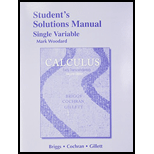
Concept explainers
U.S. population projections According to the U.S. Census Bureau, the nation’s population (to the nearest million) was 281 million in 2000 and 310 million in 2010. The Bureau also projects a 2050 population of 439 million. To construct a logistic model, both the growth rate and the carrying capacity must be estimated. There are several ways to estimate these parameters. Here is one approach:
a. Assume that t = 0 corresponds to 2000 and that the population growth is exponential for the first ten years; that is, between 2000 and 2010, the population is given by P(t) = P(0)ert. Estimate the growth rate r using this assumption.
b. Write the solution of the logistic equation with the value of r found in part (a). Use the projected value P(50) = 439 million to find a value of the carrying capacity K.
c. According to the logistic model determined in parts (a) and (b), when will the U.S. population reach 95% of its carrying capacity?
d. Estimations of this kind must be made and interpreted carefully. Suppose the projected population for 2050 is 450 million rather than 439 million. What is the value of the carrying capacity in this case?
e. Repeat part (d) assuming the projected population for 2050 is 430 million rather than 439 million. What is the value of the carrying capacity in this case?
f. Comment on the sensitivity of the carrying capacity to the 40-year population projection.
Want to see the full answer?
Check out a sample textbook solution
Chapter D1 Solutions
Student Solutions Manual, Single Variable for Calculus: Early Transcendentals
- Find the indefinite integral. Check Answer: 7x 4 + 1x dxarrow_forwardQuestion 1: Evaluate the following indefinite integrals. a) (5 points) sin(2x) 1 + cos² (x) dx b) (5 points) t(2t+5)³ dt c) (5 points) √ (In(v²)+1) 4 -dv ขarrow_forwardFind the indefinite integral. Check Answer: In(5x) dx xarrow_forward
- Find the indefinite integral. Check Answer: 7x 4 + 1x dxarrow_forwardHere is a region R in Quadrant I. y 2.0 T 1.5 1.0 0.5 0.0 + 55 0.0 0.5 1.0 1.5 2.0 X It is bounded by y = x¹/3, y = 1, and x = 0. We want to evaluate this double integral. ONLY ONE order of integration will work. Good luck! The dA =???arrow_forward43–46. Directions of change Consider the following functions f and points P. Sketch the xy-plane showing P and the level curve through P. Indicate (as in Figure 15.52) the directions of maximum increase, maximum decrease, and no change for f. ■ 45. f(x, y) = x² + xy + y² + 7; P(−3, 3)arrow_forward
- EX-let d'be ametric on a vector space X induced from a norm hx and d defind by a Slab)= {od (a, if a = b (a,b)+is ab Show that cannot be induced froman norm on X. 2) let à be trivel metric show that I cannot be induced from an norm on X- 3) let M be closed subspace of anormed spacex Construct the space X/Mas a normed space. 4) let Mix be vector space of 2x3 matrices on R write with Prove convex set and hyper Plane of M 5) show that every a finite dimension subspace of anormed space is closed.arrow_forwardplease do #48arrow_forward43–46. Directions of change Consider the following functions f and points P. Sketch the xy-plane showing P and the level curve through P. Indicate (as in Figure 15.52) the directions of maximum increase, maximum decrease, and no change for f. ■ 45. f(x, y) = x² + xy + y² + 7; P(−3, 3)arrow_forward

 Glencoe Algebra 1, Student Edition, 9780079039897...AlgebraISBN:9780079039897Author:CarterPublisher:McGraw HillAlgebra & Trigonometry with Analytic GeometryAlgebraISBN:9781133382119Author:SwokowskiPublisher:Cengage
Glencoe Algebra 1, Student Edition, 9780079039897...AlgebraISBN:9780079039897Author:CarterPublisher:McGraw HillAlgebra & Trigonometry with Analytic GeometryAlgebraISBN:9781133382119Author:SwokowskiPublisher:Cengage


